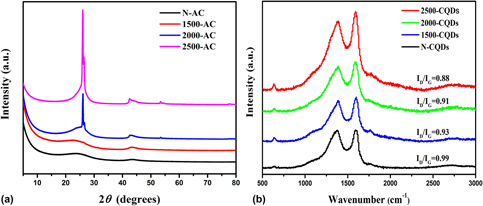Crossref Citations
This article has been cited by the following publications. This list is generated based on data provided by
Crossref.
Kamali, Siti Raudhatul
Chen, Chang-Nan
Agrawal, Dinesh Chandra
and
Wei, Tai-Huei
2021.
Sulfur-doped carbon dots synthesis under microwave irradiation as turn-off fluorescent sensor for Cr(III).
Journal of Analytical Science and Technology,
Vol. 12,
Issue. 1,
Hu, Yuefang
Chen, Yuxin
Tang, Quan
and
Liu, Hanfu
2021.
A sandwich-type ECL immunosensor for the sensitive determination of CEA content based on red emission carbon quantum dots as luminophores.
New Journal of Chemistry,
Vol. 45,
Issue. 28,
p.
12613.
Xu, Yalan
Wang, Chan
Ran, Guoxia
Chen, Dan
Pang, Qingfeng
and
Song, Qijun
2021.
Phosphate-Assisted Transformation of Methylene Blue to Red-Emissive Carbon Dots with Enhanced Singlet Oxygen Generation for Photodynamic Therapy.
ACS Applied Nano Materials,
Vol. 4,
Issue. 5,
p.
4820.
Thangaraj, Baskar
Solomon, Pravin Raj
Chuangchote, Surawut
Wongyao, Nutthapon
and
Surareungchai, Werasak
2021.
Biomass‐derived Carbon Quantum Dots – A Review. Part 1: Preparation and Characterization.
ChemBioEng Reviews,
Vol. 8,
Issue. 4,
p.
265.
Mansuriya, Bhargav D.
and
Altintas, Zeynep
2021.
Carbon Dots: Classification, Properties, Synthesis, Characterization, and Applications in Health Care—An Updated Review (2018–2021).
Nanomaterials,
Vol. 11,
Issue. 10,
p.
2525.
Zhao, Yunyang
He, Bingchen
Liu, Enshan
Li, Jielei
Wang, Liming
Chen, Shi
Chen, Yeqing
Tan, Zhan’ao
Ng, Kar Wei
Wang, Shuangpeng
Tang, Zikang
and
Qu, Songnan
2021.
Aluminum-Based Surface Polymerization on Carbon Dots with Aggregation-Enhanced Luminescence.
The Journal of Physical Chemistry Letters,
Vol. 12,
Issue. 19,
p.
4530.
Jung, Hwapyung
Sapner, Vijay S.
Adhikari, Arindam
Sathe, Bhaskar R.
and
Patel, Rajkumar
2022.
Recent Progress on Carbon Quantum Dots Based Photocatalysis.
Frontiers in Chemistry,
Vol. 10,
Issue. ,
Ranjan, Pushpesh
Khan, Raju
Gogoi, Satyabrat
Murali, S.
Sadique, Mohd. Abubakar
Yadav, Shalu
and
Khan, Akram
2022.
Carbon Dots in Agricultural Systems.
p.
1.
Kumar, Pawan
Dua, Shweta
Kaur, Ravinder
Kumar, Mahesh
and
Bhatt, Geeta
2022.
A review on advancements in carbon quantum dots and their application in photovoltaics.
RSC Advances,
Vol. 12,
Issue. 8,
p.
4714.
Chen, Hao-Ran
Meng, Wei-Ming
Wang, Ri-Yuan
Chen, Fang-Lin
Li, Tao
Wang, Ding-Ding
Wang, Feng
Zhu, San-E
Wei, Chun-Xiang
Lu, Hong-Dian
and
Yang, Wei
2022.
Engineering highly graphitic carbon quantum dots by catalytic dehydrogenation and carbonization of Ti3C2Tx-MXene wrapped polystyrene spheres.
Carbon,
Vol. 190,
Issue. ,
p.
319.
Rong, Xing
Cao, Qing
Gao, Yan
Du, Xin
Dou, Huawei
Yan, Min
Li, Shijie
Wang, Qian
Zhang, Zhanchao
and
Chen, Baoming
2023.
Performance optimization and kinetic analysis of HNO3 coupled with microwave rapidly modified coconut shell activated carbon for VOCs adsorption.
Frontiers in Energy Research,
Vol. 10,
Issue. ,
Michenzi, Cinzia
Espro, Claudia
Bressi, Viviana
Celesti, Consuelo
Vetica, Fabrizio
Salvitti, Chiara
and
Chiarotto, Isabella
2023.
Electrochemical bottom-up synthesis of biomass-derived carbon dots for promoting Knoevenagel condensation.
Molecular Catalysis,
Vol. 544,
Issue. ,
p.
113182.
Ayedi, Noussaiba
Rzig, Boutheina
and
Bellakhal, Nizar
2023.
Catalytic Hydrothermal Carbonization of Olive Wood Charcoal for Methylene Blue Adsorption from Wastewater: Optimization, Isotherm, Kinetic and Thermodynamic Studies.
Chemistry Africa,
Vol. 6,
Issue. 2,
p.
765.
Padasalagi, Anita B.
and
Rabinal, M.K.
2023.
Synthesis of multicolour luminescent graphitic carbon nitride quantum dots through controlled graphitization and surface states.
Diamond and Related Materials,
Vol. 140,
Issue. ,
p.
110432.
Kaur, Harmandeep
Singh, Manpreet
Singh, Kuldeep
Kumar, Arvind
and
Kang, Tejwant Singh
2023.
Sustainable preparation of oxidized graphitic material from wheat straw using a deep eutectic solvent for superactivity of cellulase.
Green Chemistry,
Vol. 25,
Issue. 13,
p.
5172.
Yang, Zheng
Xu, Tiantian
Li, Hui
She, Mengyao
Chen, Jiao
Wang, Zhaohui
Zhang, Shengyong
and
Li, Jianli
2023.
Zero-Dimensional Carbon Nanomaterials for Fluorescent Sensing and Imaging.
Chemical Reviews,
Vol. 123,
Issue. 18,
p.
11047.
Thakur, Abhinay
Kaur, Harpreet
Kumar, Ashish
and
Bashir, Sumayah
2023.
Carbonaceous Quantum Dots: Synthesis And Applications.
p.
53.
Xu, Shiyong
Zhang, Jiqiao
Li, Mei
Jin, Zhiliang
and
Wang, Yijun
2023.
In situ synthesis of S‐doped coal‐based carbon quantum dots and its application to Cr6+ detection.
Journal of Chemical Technology & Biotechnology,
Vol. 98,
Issue. 10,
p.
2532.
Mohammadpour, Zahra
Askari, Esfandyar
Shokati, Farhad
Hoseini, Hosna Sadat
Kamankesh, Mojtaba
Zare, Yasser
and
Rhee, Kyong Yop
2023.
Synthesis of Fe-Doped Peroxidase Mimetic Nanozymes from Natural Hemoglobin for Colorimetric Biosensing and In Vitro Anticancer Effects.
Biosensors,
Vol. 13,
Issue. 6,
p.
583.
Ozyurt, Derya
Kobaisi, Mohammad Al
Hocking, Rosalie K.
and
Fox, Bronwyn
2023.
Properties, synthesis, and applications of carbon dots: A review.
Carbon Trends,
Vol. 12,
Issue. ,
p.
100276.



